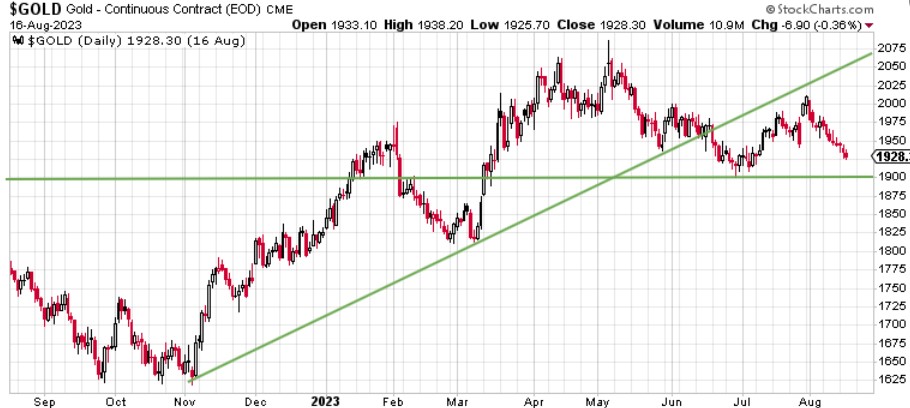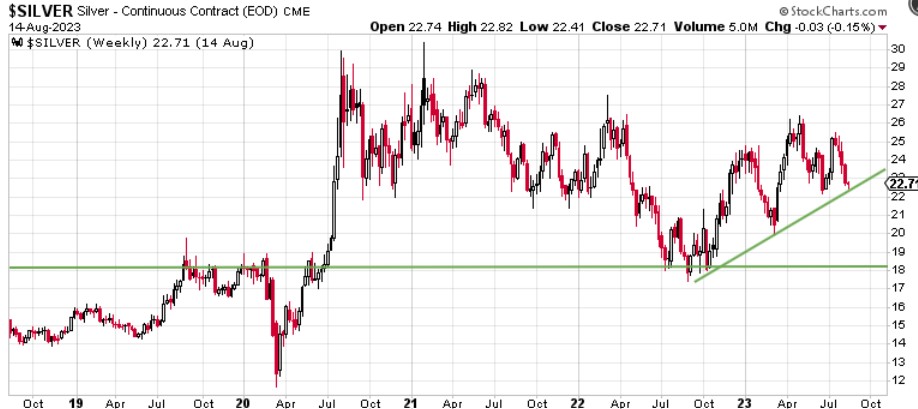
August 2023
This summer, gold and silver seem to have decided to fall back on the old adage, "Sell in May and go away until Labor Day." The price action has been pretty dull. For those who are accumulating the metals in the face of increasing US political, geopolitical, and economic tensions, this is all a gift. We don't know of any serious precious metals market analysts who see the price of gold (and silver) collapsing in the coming months and years. On the contrary, with each passing month, the long-term outlook for these hard assets gets stronger.
For the remainder of 2023, gold is expected to maintain its appeal as a hedge against economic uncertainties such as inflation, fluctuations in global currencies, and a potential stock market correction. Traditionally, interest rate hikes limit its upside potential. However, that is only true when the financial system is healthy.
Today, with the enormous glut of global debt, interest rate hikes to combat inflation are becoming seen as an increasing threat to the viability of the present financial system. At some point, higher rates will cease to become a competitor with gold, and instead, boost demand for it. Meanwhile, silver as an industrial metal continues to see increasing demand in applications such as technology and renewable energy.
All of this leads us to be more confident than ever that gold pricing will continue to find solid support in the $1,850 to $1,900 range as it waits for what seems inevitable--a major financial disruption, expanding war, or both. Then the catalyst for a sustained upward move will have been triggered.
Gold and Silver
What Do the Charts Say?


The charts at this time are not very exciting. Looking at the one-year chart for gold, when the price didn't break out convincingly above the $2,000 per ounce level and then failed to hold the uptrend line, it signaled that the market was entering a consolidation phase. This isn't really a surprise. These happen when the price becomes range-bound for a period of time while the market gains the "energy" needed to sustain a run above a new high. We anticipate $1,900 will provide significant support. However, the price could temporarily move lower. At this point, it's a waiting game and an opportunity to accumulate.
Silver has tracked gold fairly well over the course of this summer. For the moment, while interest rates are pressuring gold to the downside, commodity inflation is providing some support for silver. We are at a point where silver will decide whether to bounce off of the short-term uptrend line or penetrate it. Should it do so on the downside, and if for some reason it fell into the $18s, it could turn out to be a long-term buy of the decade.
Debt is now a major issue...
Is the US debt downgrade by Fitch from AAA to AA+ "a big deal"? Of course, it depends on who you ask. On August 5th, 2011, Standard and Poors downgraded US debt on the heels of years of government spending to lift the world out of "The Great Recession." At that time, US government debt was approximately $14.8 trillion, and the government deficit was $1.3 trillion. Today, the "official" numbers are $32.8 trillion and $1.4 trillion. This, of course, does not count the trillions in extra spending from the COVID years, nor does it count "off-budget" spending, which is also estimated in the trillions.
With a second rating agency giving US debt a downgrade (S&P did not restore its AAA rating), the trend is certainly not your friend if you are a US bondholder. In fact, one look at the following graph and we can speculate that the downgrade trend will only accelerate. It is the graph of payments the US government makes on the interest on its debt and is one of the best cases for owning gold and silver as financial assets. Historically, things like this have not ended well.
